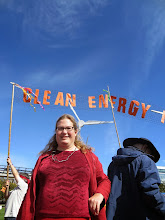The word "community" itself is ill-defined. Is New York City a community? Just what makes a project somehow special enough to be considered community-like?
A community solar project might be in a single array or multiple arrays throughout an area. It might be a solar garden - shared solar, operating on a subscription model. It might use virtual net metering to supply people in a given housing complex, town, or utility service area. It might be crowdfunded, with money from many small investors. It might be community-controlled, owned by a cooperative where members have some degree of say.
Some definitions give a size range. Colorado's Community Solar Gardens Act tops out at 2 Megawatts (2000 kilowatts). California's proposed SB43 places the maximum size for a shared solar project at 20 MW (20,000 kW). Distributed solar is connected to the distribution grid, as rather than the transmission grid - at a maximum 30 MW.
Here's a tour of a few of the largest, from the largest "largest" project down to the smallest largest project. Please let me know at joy@solargardens.org if I have left out yours!
Copper Crossing Solar Ranch, Arizona - 20.0 MW
This is about as big as you can get and still be called community solar. This 144-acre project, built for the Salt River Project by Ibedrola Solar, supplies a hundred schools. Impressive!
Hall's Pond Solar Cooperative, Ontario, Canada (Proposed) - 7.5 MW
In the solar industry, we spend a lot of time out standing in various fields. This Ontario cooperative has raised CA$200,000, and intends to raise 30% of its money from its members.
Keystone Solar Project, Pennsylvania - 6.0 MW
Westmill Solar Co-Op, Oxfordshire, England - 5.0 MW
The world's largest cooperatively-owned solar project resides in rainy old England. This really demonstrates how a feed-in tariff or CLEAN program can promote local solar development! Shares in this project sold out rapidly - the project was build by Blue Energy.
Mesa County Solar Garden, Colorado (Proposed) - 2.0 MW
One of the largest projects under the Community Solar Gardens Act, Ecoplexus Inc. is actively developing an array on XCEL Energy territory near Grand Junction, Colorado. Terry Franklin, utility manager for the city of Grand Junction, said, "Colorado Mesa University wants to be a subscriber, the City of Grand Junction wants to be a subscriber, School District 51 wants to be a subscriber and then a minimum of five percent of low-income families are a requirement through the Xcel Process."
SMUD Solar Shares, California - 1.2 MW
The grandaddy of 'em all, this 2008 project was one of the first solar gardens in America, and remained the largest for a considerable period. The program allows customers of the Sacramento Municipal Utilities District to purchase blocks of solar power which are credited to their electric bills.
SMPA Community Solar Array, Colorado - 1.1 MW
The largest solar garden currently under operation in Colorado, this project on the San Miguel Power Association will provide power to over 200 subscribers. The SMPA Community Solar Array is located on seven acres in the northwest corner of Paradox Valley along U.S. Highway 90, about 15 miles west of Naturita, Colo. Customers in the SMPA territory will purchase individual panels for $705, net of rebates from SMPA. Customer can purchase as few as one panel or enough to offset 100% of their electricity needs, and receive credit for the power produced directly on their monthly utility bills.
Valencia Gardens Solar, California - 0.7 MW
California's largest virtual net metered solar project, this 700-kilowatt grouping of arrays provides power to an affordable housing complex in San Francisco. Under California's Multifamily Affordable Solar Housing (MASH) program, the power will be allocated to each apartment proportional to square footage.














